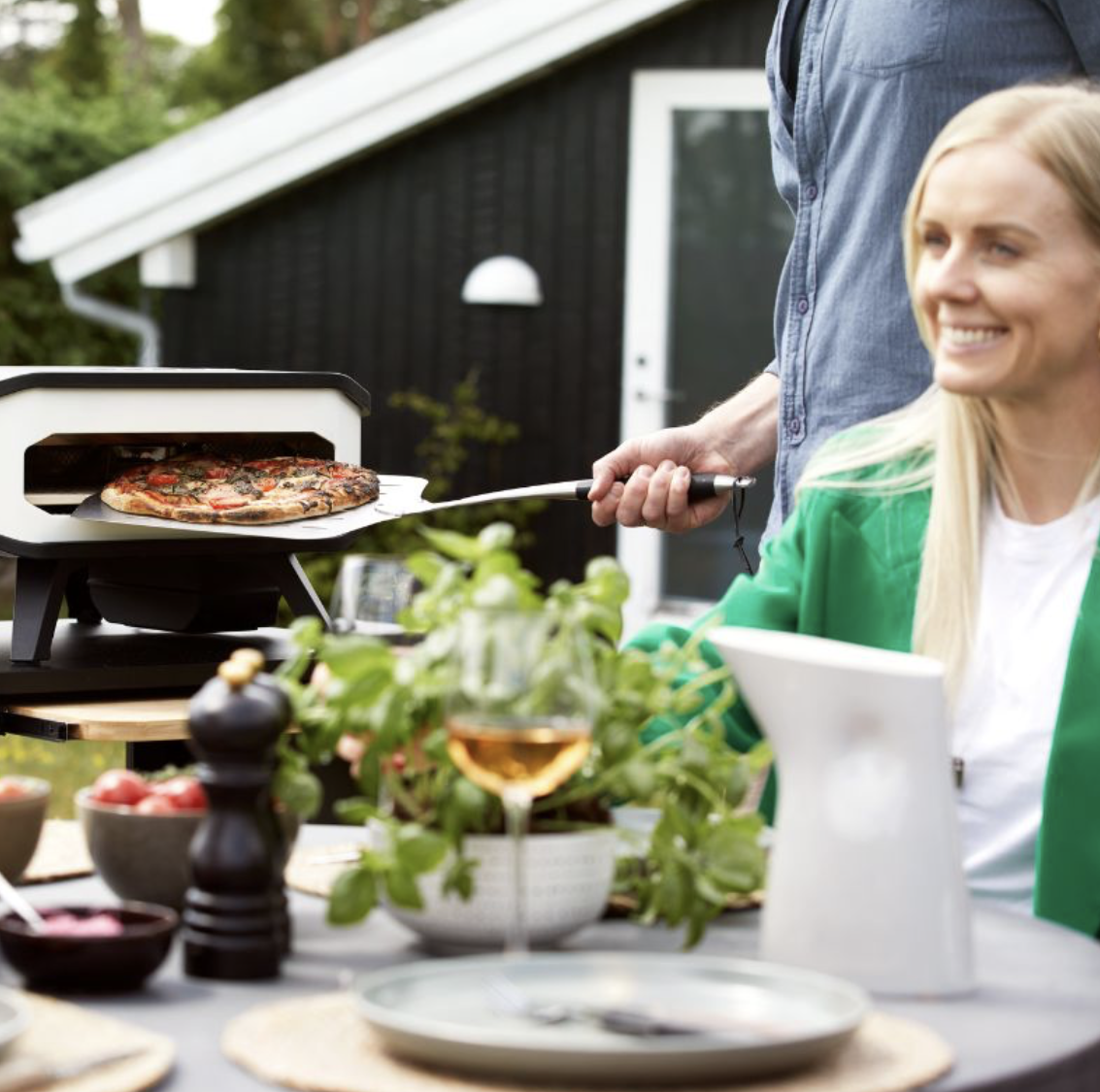We've received a few messages on our socials asking how best to clean our pizza ovens, so we thought we would share our method for general upkeep and some of the pizza oven-cleaning tips and tricks we’ve picked up.
Whilst a pizza oven never gets as dirty as a gas or charcoal BBQ, it will still get mucky with regular outdoor use. It just can’t be avoided when you're cooking food outside. However, a regular light clean after each use is the best way to keep them looking great and in tip-top working order.
Our Cozze Pizza Ovens have proven to be incredibly popular with Lazy Susan customers, so much so that a larger 17” Outdoor Gas Pizza Oven (pictured above) will soon be joining the 13” Outdoor Gas Pizza Oven we launched a few summers back. But more info on that will be coming soon, so please watch this space!
How to clean your Lazy Susan Cozze pizza oven

The body of our Cozze Pizza Ovens is made from zinc-plated steel that is powder coated with a matt black finish (shown in the photo above). The metal is treated with an anti-rust lacquer, which further ensures the steel is fit for outdoor use.
You generally tend to find that the inside of the oven doesn’t get too dirty as the food is placed on the supplied Cordierite Pizza Stone.
If there is a bit of food residue (burnt mozzarella is a common one) in there after cooking, then one of the best ways we have found to clean it is to leave it at a high temperature for around 15 to 20 minutes to "burn it off".
Once it has cooled to a safe temperature, you can carefully scrape it with a plastic scraper/spatula and brush out (or hoover) any of the loose debris.
For this job, we would recommend that you invest in a pizza oven brush with a scraper such as the Pizzacraft (shown above). It has palm stem fibre bristles that will clean the pizza stone and the inside of your oven without scratching it, while the scraper can be used to gently pry off any stubborn burnt-on residue.
You can also wipe the inside of the oven with a clean damp cloth but never use any cleaning solutions such as washing up liquid on the inside of your oven or the pizza stone as it can spoil the taste of your pizza when next used.
In terms of how often you should do this, we would advise after every use really. Keep on top of it. Once you've burned off any food spills and left it to cool, it's only a 5-min job to clean and wipe down and, it will prevent any bigger issues from taking hold when left to build up.

Pro Pizza Oven Tip
All cleaning and maintenance should be carried out when the pizza oven is cool to the touch and with the gas supply turned off at the cylinder. Please also note that modern stainless steel ovens such as the Cozze are better insulators than the traditional brick pizza ovens. They hold their heat for much much longer, so allow plenty of time for them to cool before cleaning.
To clean the outside surface of your Cozze oven, all you need is a squirt of washing-up liquid in warm water, wipe it down with a soft microfibre cloth and then dry it with a tea towel.
If you have any stubborn grease stains or watermarks, then add a tablespoon of baking soda to warm water in a clean spray bottle, spray on the solution, leave it to fizz for 10 seconds or so, and then wipe it off with a damp microfibre cloth.
If watermarks are visible after the metal is dry (common with stainless steel), then just spray on a little glass cleaner and wipe with a glass cloth and it buffs the surface to a nice even finish.
Any of the plastic surfaces can also be washed with the above solutions but you should avoid using any abrasive cleaners, degreasers or concentrated barbecue cleaning solutions on any part of your pizza oven as they can damage/dull the finish.
How to clean your pizza stone

Our Cozze Pizza Ovens come supplied with a Cordierite Pizza Stone, which to get all scientific is a magnesium iron aluminium cyclosilicate. In other words, it is made from a mineral that can handle extreme temperatures so it is perfect for cooking pizza quickly and evenly.
It is the same material commonly found inside a kiln for firing pottery so you can quickly take it from cold to super hot (our Cozze ovens are ready to cook and up to temp in 20 minutes and a pizza will cook in less than 2) without any cracking.
However, whilst they are designed to resist “thermal shock”, you do need to ensure they are cleaned correctly.
As we’ve already mentioned, we avoid using any cleaning solutions (even washing-up liquid) on our pizza stones as they’re porous and it can spoil the taste of your pizza.
The aforementioned “burn-off” method generally does the trick. However, if you want to give them a regular clean, then wait until fully cooled and wipe them with a microfibre cloth soaked in just warm water and that should remove any food residue.
The more you use your pizza stone the more it will potentially discolour from the heat. However, this is perfectly normal and will not affect the taste of your pizzas.

If your stone is looking a little unsightly, then any abrasive cleaners and chemicals are a definite no-no. The best solution is to mix up a paste of equal parts baking soda and warm water.
Apply with your fingers, leave it to fizz on the surface for a couple of minutes then rinse off with warm water. This should lift the worst of the muck without imparting any nastiness onto your next pizza.
Never submerge your pizza stone in water or put it in the dishwasher as excess water can penetrate the stone and cause it to crack.
Our advice is to always give it a clean after you've finished using the oven and when the stone is cold to the touch.
Do not put a damp stone in your pizza oven too. Make sure it is fully dry before you cook on it again.
Hopefully, we have covered everything in this article in terms of how to safely clean your outdoor pizza oven, however, if you do have any further questions or concerns, then please don’t hesitate to contact our Customer Service Team.
If you have any photos of your Cozze Pizza Oven at your next garden party, then we’d love to see a few snaps for our Do Some Good charity campaign. You can tag us @LazySusanFurniture on Instagram or Facebook or email them to us at [email protected].





